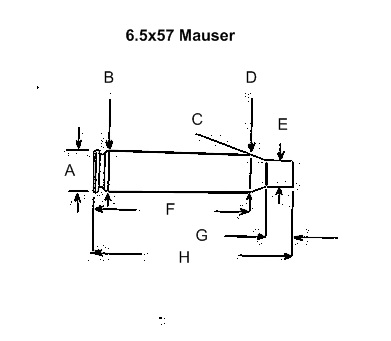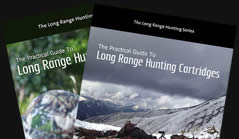6.5x57
History
Like the 7x57, the 6.5x57 Mauser is based on the M/88 8x57mm case. Information regarding the development of the 6.5x57 is scarce however the suggested year of introduction, 1890, occurred at a similar time to Mauser’s involvement in attempts to develop a 6.5 caliber rifle for the Italian military (see 6.5x55 text). The 6.5x57 never saw military service although research no doubt helped later in the design of the military 6.5x58 Portuguese Mauser. Introduced as a sporting cartridge, the 6.5x57 was initially loaded with a 154 grain round nosed bullet producing 2400fps. Because of this long bullet, rifles chambered in 6.5x57 had extremely long throats, like the Swede. These specifications now CIP certified, are still used in Europe today.Since its introduction the 6.5x57 has grown to become a standard German deer stalking cartridge. Two main factors influence the common use of the 6.5x57 and the first of these is German law. German caliber restrictions state firstly that for Roe deer any caliber may be used, as long as the projectile has a minimum impact energy of 1000 joules (738ftlbs) at 100 meters (110 yards). However for all other hoofed game, this includes Chamois, Fallow, Boar and Red deer, the minimum caliber allowable is 6.5mm and must yield 2000 Joules or 1475ftlbs at 100 meters or 110 yards. With modern German factory ammunition, the 6.5x57 is the minimum allowable cartridge certifiable for all round hunting. The second factor influencing the use of the 6.5x57 in Germany is that the 6.5 caliber and local loadings help ensure minimal meat damage as often the carcass is destined for sale.
A second version of the 6.5x57 is the 6.5x57R rimmed version for break open rifles. Besides the rim, other case dimensions are the same as the parent design.
Performance
The 6.5x57 is very similar in performance to the 6.5x55. Velocities of both cartridges are near identical. Factory ammunition is typically weak in comparison to hand loads.
Factory Ammunition
Although case designations describe the 6.5x57 as being 2mm longer than its nearest relative the 6.5x55, the 6.5x55 has a slightly larger base diameter. This coupled with the thick brass used in RWS ammunition leads to lower velocities in factory ammunition than those produced by either 6.5x55 European factory ammunition or 6.5x57 hand loads using U.S made brass.RWS list several loads for the 6.5x57 in both rimmed and rimless cases measured from a 24" barrel. A most noticeable feature of RWS 6.5x57 ammunition is the variety of light weight loadings, developed to meet Germanic hunters trends. The 92.6 grain T Mantel, designed for fast expansion and fragmentation is advertised at a velocity of 3231fps. Slightly stouter is the 108 grain KS normally known as the Cone Point, this is a traditional conventional style projectile with a velocity of 2854fps. The 127 grain KS is the heaviest cone point used in 6.5x57 at 2739fps.
The KS or cone point, designed in the mid 1970's, was developed as part of an effort to produce lighter bullet weights for hunters. The design of the cone point incorporates a short, steep angled ogive. This helps to decrease bullet jump and enhance accuracy in the long throated 6.5x57 rifles. The 127 grain loading was the first to be produced but it was found that it's poor BC's gave it poor down range velocities and performance on game. The 108 grain load came in response to this but again, down range performance is left wanting in comparison to the popular 93 grain T Mantel. Nevertheless, at close ranges, the KS is very effective and wounding is extremely similar to the 129 grain Hornady SST.
The heaviest load offered by RWS is the 140 grain DK bullet at 2657fps. The DK or dual core bullet is constructed similarly to the Nosler Partition, having a copper bridge across it's mid section isolating the rear portion from continued expansion. The dual core is advertised as 'Always producing an exit hole' on medium game. This refers to cross body and slightly quartering shots as it considered unethical in Europe to shoot game facing away at steep angles or facing directly away.
Besides RWS, export 6.5x57 ammunition is also produced by Sellier & Bellot. Only one load is offered, a 131 grain soft point at 2540fps. The 131 grain bullet is conventional in design and a mild performer on game. Sellier & Bellot are presently offering loadings in other calibers using the Sierra GameKing and Barnes bullets, however some traditional European loadings such as the 6.5x57 and 8x57 remain unchanged.
Hand Loading
For western hunters, due to the scarcity of factory ammunition, the 6.5x57 is essentially a hand loading proposition. Hand loads using U.S produced 7x57 brass necked down to 6.5 combined with U.S powder and projectiles exceed factory performance considerably.6.5x57 brass is easily formed by necking down 7x57 brass in a 6.5x57 die. For more control during fire forming a first step can be added by necking 7x57 brass up to .30 caliber, then running it through the 6.5x57 die, this leaves a larger false shoulder for head spacing. Using Winchester, Norma or Lapua brass gives an immediate improvement in case capacity and therefore velocity over the heavy walled RWS brass.
6.5x55 load data can be used in absence of 6.5x57 data due to case capacities being near equal, resulting in similar velocities. Normal loads in the 6.5x57 give a shade under 3000fps with 120 grain bullets and 2800fps with 140 grain bullets. Accordingly, bullet performance on game is identical.
Closing Comments
In recent years, it has been a popular practice to improve the 6.5x57 case to Ackley specifications, removing much of the body taper and blowing the shoulder forwards to form a steeper shoulder. The 6.5x57 Ackley Improved gives performance very similar to the 6.5-06, pushing 120 grain bullets in excess of 3100fps while 140 grain loads achieve over 2900fps. The 6.5x57 AI is also very similar to but not identical to the wildcat 6.5x257 Roberts Improved which is commonly known as the .260AAR (all around rifle). Case lengths are the same however the 6.5x57 AI has a shallower shoulder that sits further forwards creating a shorter neck. Both of these wildcats have enjoyed limited popularity with shooters since the mid 1960's.Germany's solution to increasing the killing power of the 6.5x57 was the development of the 6.5x65 RWS in 1989. The 6.5x65 is based on the .30-06 case albeit slightly longer, with its shoulder further forwards and is loaded to a short overall length to allow cartridges to fit within existing 6.5x57 rifle magazines (84mm). This design allows rifle owners to have their 6.5x57 rifles reamed to the big cartridge which gives significant gains in velocity and increased shocking power at range. The 6.5x65 does away with the long throat of old while keeping with the trend towards the use of light bullets. RWS factory ammunition features the 127 KS at 3250fps giving an increase of 510fps over the 6.5x57 and a noticeable increase in killing power.
Note: See 6.5x55 for suggested loads.

| Imperial | Metric | |
| A | .470 | 11.95 |
| B | .468 | 11.90 |
| C | 18deg 55’ | |
| D | .431 | 10.94 |
| E | .301 | 7.65 |
| F | 1.752 | 44.50 |
| G | .291 | 7.40 |
| H | 2.232 | 56.70 |
| Max Case | 2.232 | 56.70 |
| Trim length | 2.222 | 56.46 |
Discuss this article or ask a question on the forum here
Copyright © 2007-2017 Terminal Ballistics Research, Ballisticstudies.com
|
|||||||||
|
|||||||||
FOUND THIS ARTICLE HELPFUL?If you find the resources on this website to be valuable, we would be sincerely grateful if you would consider making a donation to help us cover the costs of the website and to assist us to continue our research and testing into the future. It doesn't matter whether your donation is big or small - it makes all the difference! |
|||||||||






